Cretaceous lettering for dummies on the example of working on an art object
This is the story of the personal experience of a UX-designer, who fell in love with lettering , who did not clearly know what it is.
I will talk about what is lettering in modern design on the example of my work on an art object; about the difficulties I faced and how I solved them; about slate paint and chalk markers. And why is it "good for business". And there will be some motivation for designers who would like to get up from a chair, but do not know how.

It all started with the fact that our department had the task to make huge letters FU N. So that from the floor to the ceiling, so that the maximum fan was guaranteed to our guests from the very doorstep of the office, and the employees received a charge of cheerfulness, passing by every day.
')
What does the designer do in such cases? Nothing.
The hands - nothing.
We are graphic, product designers and interface designers - we sit down in our chair (and more often we sit in it), open Adobe Illustrator and type FUN in corporate or any other nice typeface and send the file to the advertising and production company ...
And wait.
Soon the guys will come and implement our design in real life. Glue what needs to be pasted, paint what needs to be painted ... or what they do there, these advertisers. The designer usually needs only to evaluate the result and either rejoice or sob.
And here I, the interface designer, opened Adobe Illustrator and typed it:

Very corporate, considering that the base color of the brand is black. On this, my work, in fact, ended, but to calm my conscience (and the management team), I made a mocap. Here is this:

And this:

And it became obvious that huge black letters are not fun at all.
Looking at them, I do not want to run wildly to work and develop as a specialist. They do not motivate, and even slightly oppress their mourning appearance.
This means that the task is not solved by me as a designer. Having understood this, our department gathered to brainstorm, the outcome of which was the decision to realize the mission of FUN letters to the maximum, filling them with vivid content. Bright, interesting, daring and, of course, corporate. This meant the development of a unique 3 meter by 5 meter illustration. The illustration implies the need for an illustrator, and God knows why I decided that this challenge is in my teeth.
Lettering (English lettering - drawing letters) gives the artist the freedom to turn the text into a drawing, supporting and strengthening its semantic content.

Jay roeder
Perhaps that is why lettering is so popular all over the world, because it has absorbed the strengths of two expressive means: drawing and text. Handwritten inscriptions and fonts were one of the significant trends in illustrative art last year, and you can be sure that this lettering will continue to gain popularity. Indeed, while digital technology captures an increasing part of our lives, creative people are looking for ways to re-personalize the design, to return the human element to it.
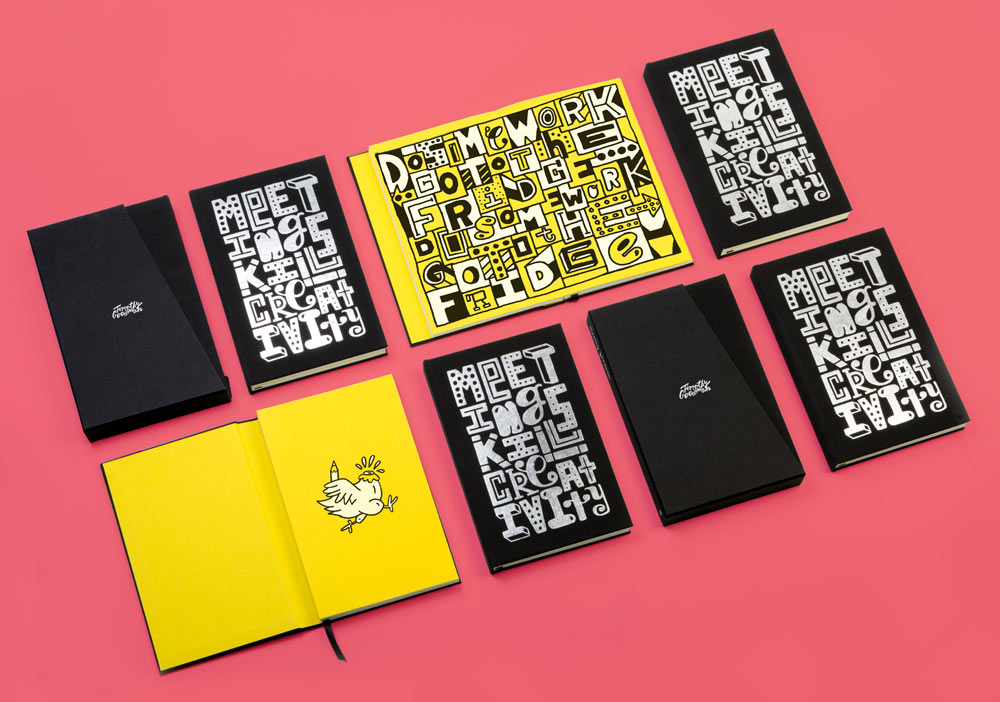
Timothy goodman
You know, there was one interesting research (alas, I don’t remember which company was involved in) where product labels were shown to consumers to choose the most pleasant options. Then the marketers were quite surprised to see that the printed and typed text with a large margin won the drawn labels. People unconsciously rated the design by hand.
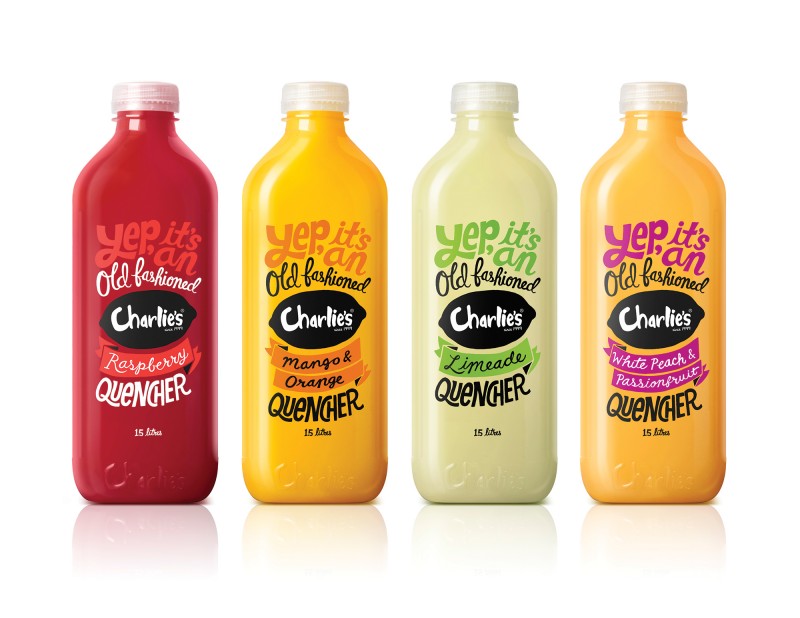
Chris Piascik
And if we see few examples of lettering in everyday life and on the streets of our native city, the reason for this is still a small popularization of this trend among the leaders of large and medium-sized businesses in Russia (at the moment). But this is an amazing thing, just look:
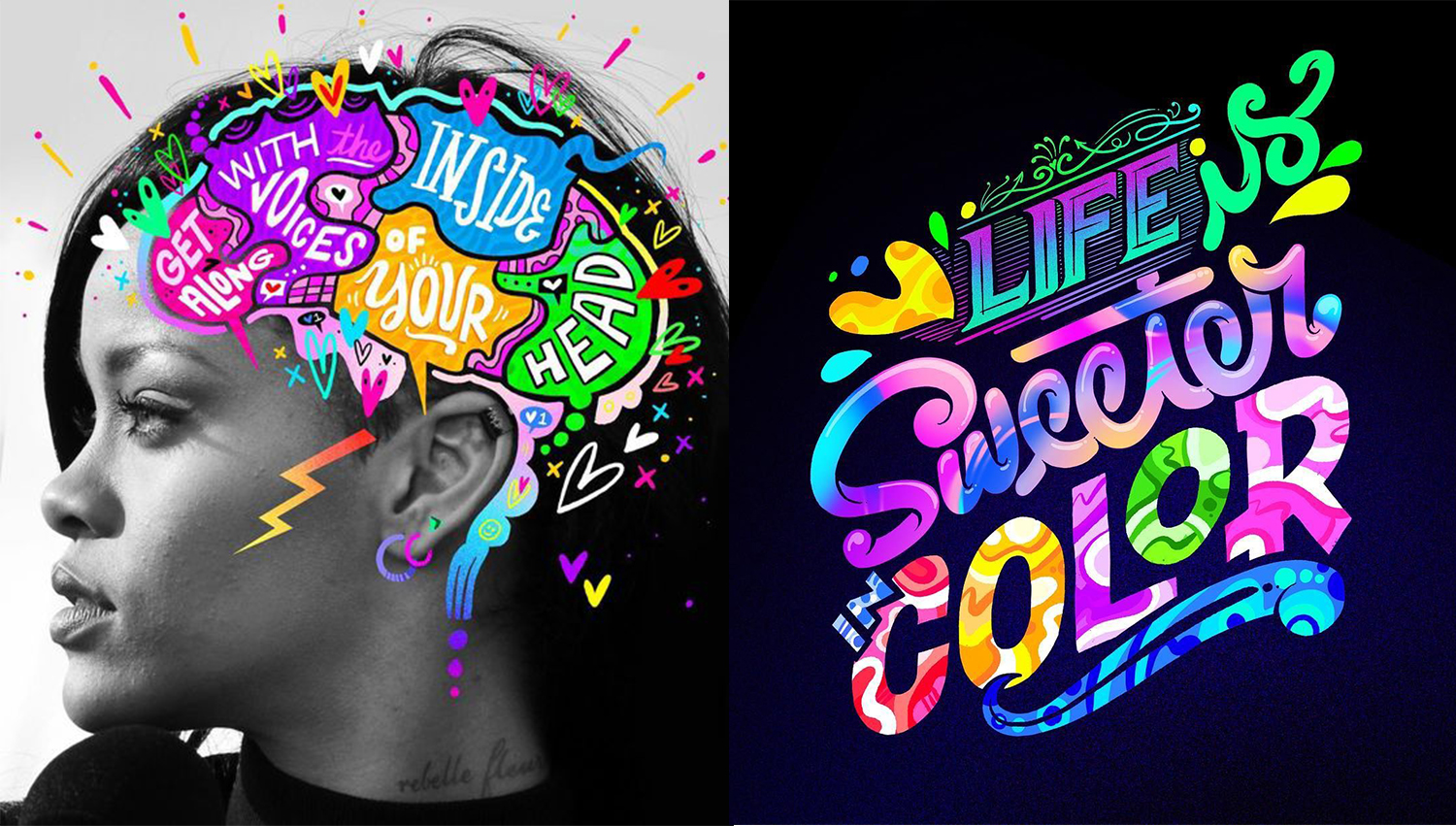
Jason naylor
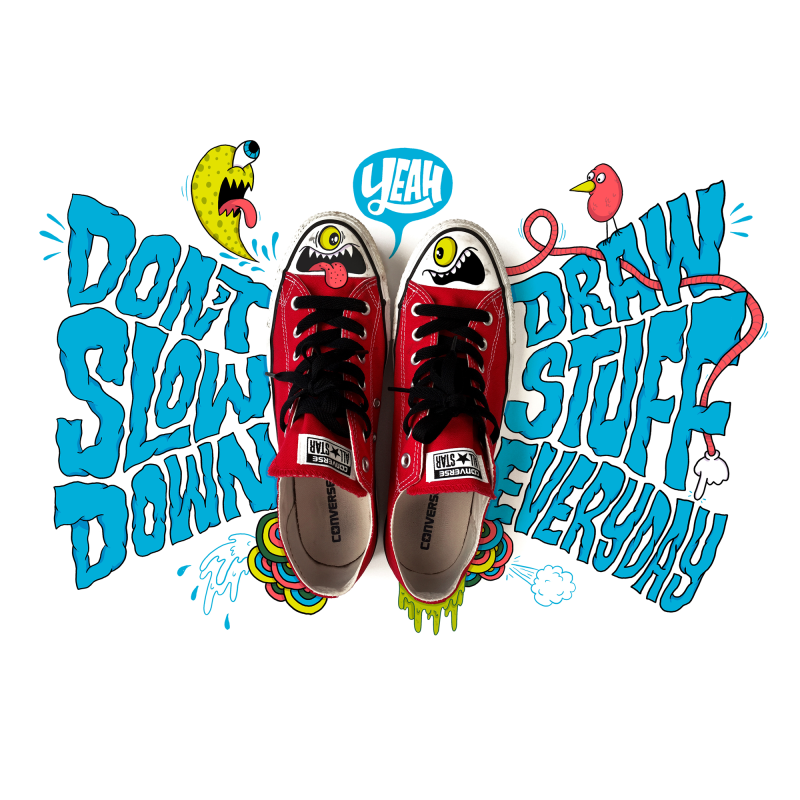

Chris Piascik
Business giants such as Google, Coca-Cola, Nickelodeon, Reebok, Converse, Nike, McDonalds, Facebook, Xbox, Forbes, Vogue, etc., boldly use lettering on a wide variety of events and in their products. And with the work of Russian and foreign lettering masters can be found on Instagram and on Behance on request #lettering . We got acquainted, were impressed and realized that we had found a fresh stream and an ideal way to transfer our ideas.
In the world of Instagram, Behance and Dribble you can now find many illustrators with their own unique styles, but if you (like me) are not one of them yet, you shouldn’t worry. Our own style is born from daily practice, but first we all look at the "great", analyze their work, charge them with energy and ideas.
One of the latest trends in illustrations in 2017–2018 is dudling (from the English. Doodle, which can be translated as “scrawl”, and doodling - unconscious drawing).
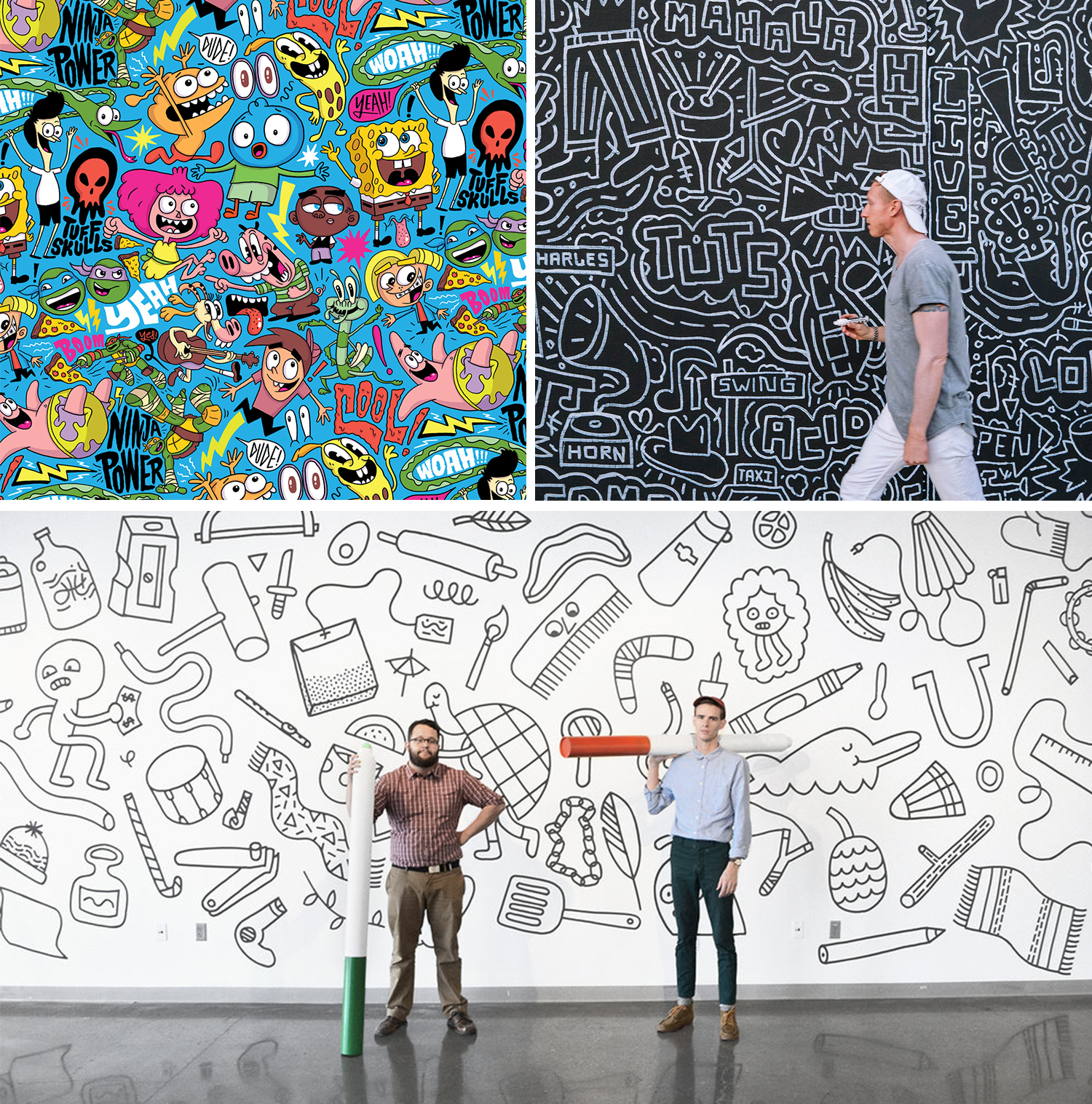
A doodle is what our hand draws while the brain is busy with another matter (for example, talking on the phone or listening to lectures). If, however, to connect consciousness to the dodling, it turns out to be a very distinctive, incredibly free illustrative style that has fascinated many.
Choosing in which direction to move, we involuntarily came to the use of doodling. Its advantage is that it is possible to organically accommodate many messages, images, phrases, slogans (and easter eggs) in one canvas, combining them with a single style space. It is interesting to examine it, reading like a book, only in an arbitrary order: from top to bottom, from right to left ...
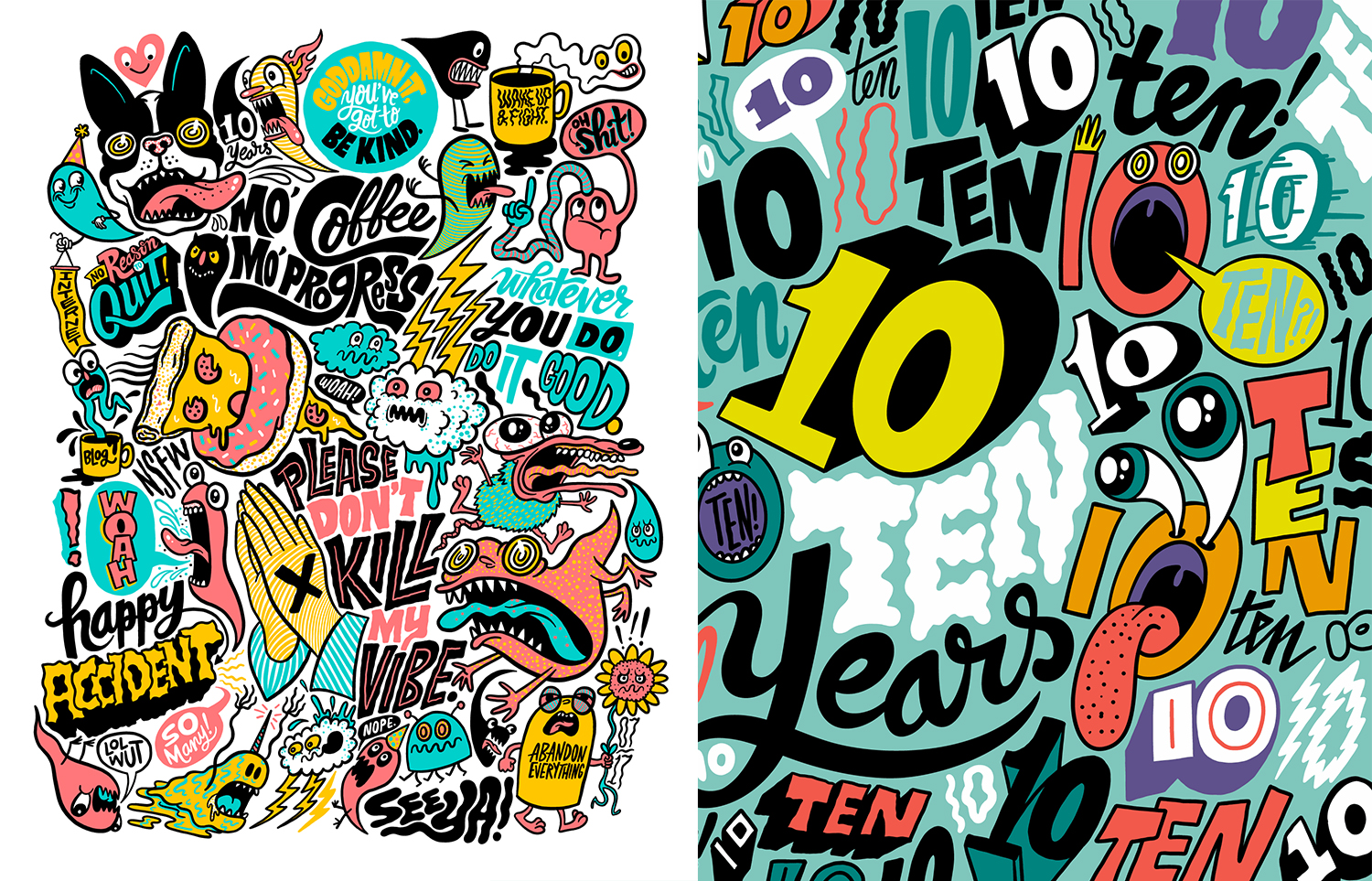
Chris Piascik
The illustrators @timothygoodman, @andyjpizza, @chrispiascik will be great sources of inspiration and a demonstration of how diverse and interesting doodle art can be.
So, we have decided on the style, it remains to generate the content, i.e. the content of our illustration.
This was the second big reason I, as a product designer, took on the task. Nobody knows and does not love your company as you yourself. An invited illustrator may bring his own style, but he is not familiar with your brand, and after all, a brand is a living being. He has a certain collective personality with a set of individual qualities that managers like so much to list in technical tasks for logo development in the column “Describe your brand”: young, innovative, reliable, stable, friendly ... Absorb all these 50 shades of the brand, rethink and broadcast as an intelligible design solution is quite difficult if you yourself are not cooking in this saucepan. Therefore, working with a third-party specialist often requires a long synchronization between the customer and the performer, which includes a magic ball fortune telling, thoughts reading sessions and endless edits that are equally painful for both parties.
We decided that nobody knows better than us how much we appreciate good fun, courage and thinking beyond the scope of the task, hooliganism on the verge of trash, informality for the sake of productivity ... everything that FunCorp creates.
And the design and administration teams met for a brainstorming session and decided on the content theme. It looked like this:

There was a hodgepodge of corporate slogans, mottos, ideas, just funny and spiritually close phrases, slightly peppered with Slack's internal jokes.
This was followed by weeks of individual work in conjunction with the iPad Pro + Apple Pencil + Adobe Draw, which I recommend to all interested parties to master because of its high technological capabilities, incredible performance and convenience. As a result, the layout of the illustration was ready to be transferred to the letters FUN, which at this point had been produced and assembled (I will talk about them in a little more detail in the chapter on chalk markers).
Of course, it is much faster and easier to print illustrations on self-adhesive film. Faster and cheaper. Cheaper and duller. And Facebook would never do that, and Facebook knows a lot about creatively enlivening the space of its offices!
In Europe and America there is such a profession, which is not in Russia, it is called signpainter. In translation, this is probably the signage artist. These are people who in our digital era with a brush and paint create signs, window dressing and building walls. Foreign artists also strongly pressed the invention of the plotter cutting, but still this profession exists and is now experiencing, perhaps, its Renaissance era (the documentary SignPainters (2014) will introduce you to it).

Mike meyer

@copenhagensigns
So why is hand-drawn or hand-made always valued higher than stamped, even if the plotter cuts out smoother? Because that's how our brain works. We feel that behind this is a real person, his living work and talent, his vision of things, and we appreciate the opportunity to touch what enriches our visual culture.
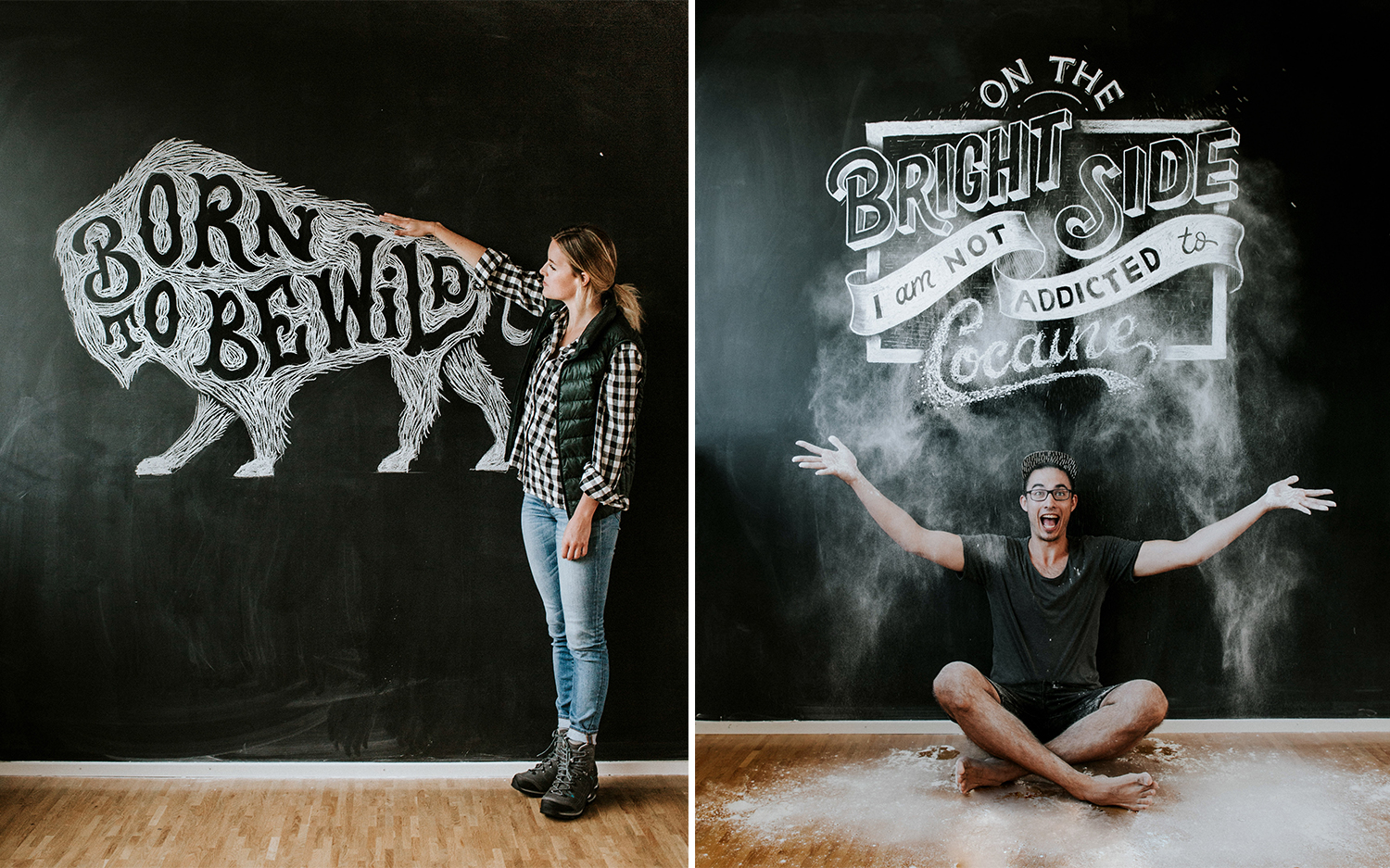
Stefan kunz
We really wanted our FUN letters to be alive, to talk to the viewer, attract the eye and fascinate his imagination, so we decided that the illustrations should be painted on the surface of the letters in the most classical way - with the hands of an illustrator. Inexperienced, but loving.
Even the designers of ancient Rome knew: ubi nihil vales, ibi nihil velis (lat.) - “where you can’t do anything, you don’t have to want anything.” A reasonable question: why go to an area where you are unprofessional?
That is, perhaps, in childhood you did a good job of drawing horses, and now you draw excellent interfaces, and your grandmother calls you an artist, but when it comes to the task within the brand design, is it wise to take responsibility for a job that you don’t even know how to approach? Risking to give out as a result unknown nonsense, for which you will at best be deprived of a quarterly bonus?
I have no answer to this question. But I think something like this we leave the comfort zone. And the comfort zone in the creative profession is a professional death.
I believe that, contrary to the prevailing stereotype, any designer is an artist. Even if he draws not with his hands, but with his head, working exclusively on the trackpad of his laptop. And when the product challenge (and the blessing of leadership) gives us designers a chance to step into a wonderful new world - it should be missed.
Acquaintance with the works of modern illustrators broke the stereotype in me that everyone should do their work, and the designer’s lot is Adobe. All these unusually talented artists in one voice say: do not be afraid to start, do not hesitate to look unprofessional, just take it and do it! And enjoy it!
Chalk markers are what the barista of the whole world writes “Cappuccino - 250 rubles” on their boards.
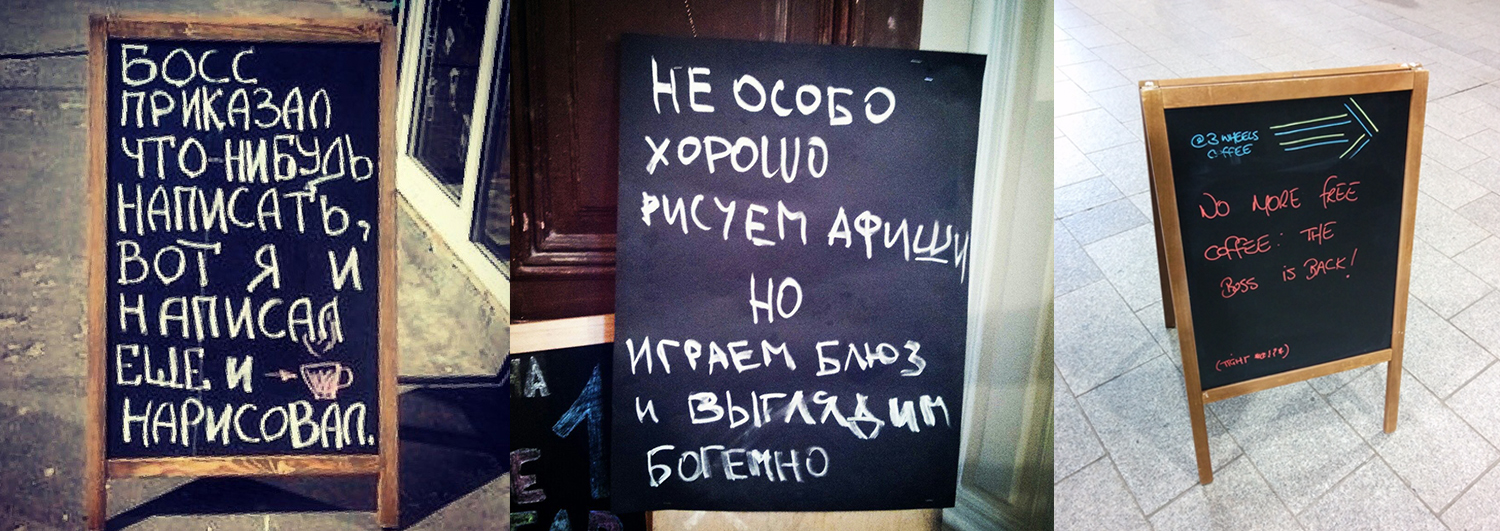
We chose the chalk markers to transfer the image to our rather big black letters. “But they are erased!” - you will say. "Exactly!" - we will answer. This means the freedom to change the content of the illustration in the future. “Well, if a barista can, then I will succeed!” - with such a slogan I began to study the lettering with chalk markers.
Immediately make a reservation, chalky lettering and lettering with chalk markers are not quite the same thing. The main difference between chalk markers from chalk is that chalk leaves a more loose, non-uniform mark; markers, on the other hand, give a clean, dense line, do not pour out and are stable after drying. These are two similar, but different tools, and it would be illiterate to say that one is better than the other, since each solves his own problems. Our problem was solved ideally by chalk markers.
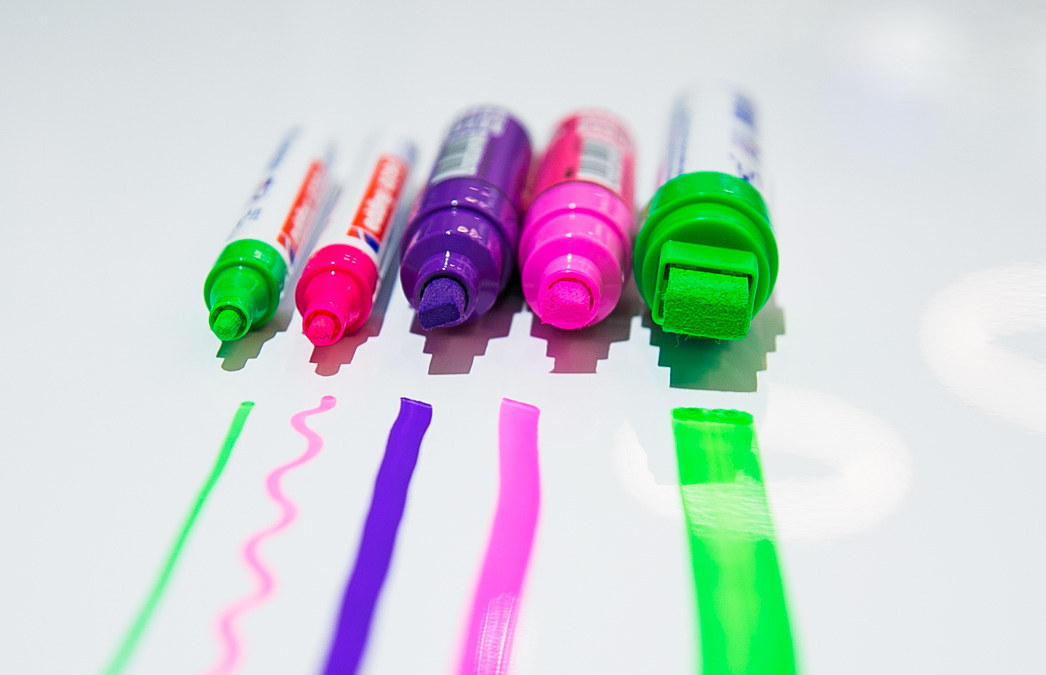
Chalk marker is also called paint marker, chalk ink, chalk pen, bistro marker, glass pen, liquid chalk, but more often chalk marker.
It's funny that this name does not correspond to reality, because, contrary to the stereotype, inside the chalk markers there is not liquid chalk, but special water-based pigment inks. This pigment has several winning points: it is resistant to ultraviolet radiation and does not fade in the sun, and also it has a very good "hiding power", that is, it well overlaps the color of the surface on which it is applied. Due to this, a very saturated color pattern is achieved. Chalk markers can be used on glass, plastic, metal, LED-board, slate paint and on other solid, non-porous surfaces. The drawing is easily washed off with a sponge with water (and even better with a sponge with a special agent for washing off chalk markers).
You yourself, most likely, are already familiar with chalk markers as a tool for children's or office creativity. You may have seen the chalk inscriptions on the boards in restaurants, shops, during the design of weddings or banquets. Meanwhile, they certainly deserve more attention.
We tried the markers of these brands personally and were satisfied: Edding, Uni Chalk .
And these are other leading brands on the market: Zig, Molotow, VersaChalk .
The market is now flooded with chalky markers from a variety of companies (including Chinese), but it is better to trust the well-known manufacturers. The average price of one marker varies from about 200 to 400 rubles, depending on the size of the tip and the amount of ink in the tank.
How to choose high-quality chalk markers? The following criteria will help you:
It could be said that the quality and density of the line first of all speak about the quality of the chalk marker, but these properties are difficult to estimate when buying a marker from an online store, and most likely it will be more convenient for you to buy them exactly there, like any narrowly specialized art product.
We have chosen for letters eco-friendly and light plywood, qualitatively primed and coated with a special blackboard paint Blackboard paint. Slate paint is not uncommon now, and observing the technology of painting, you will surely get a good result, whichever one of them is chosen. I will give only a few tips:

We made about 7 small test letters, experimenting with various combinations of materials, until we finally came to a combination of plywood and matte slate. This combo with glitter passed the test (draw - we estimate the brightness and consistency of the line - we erase it with a wet rag - we dry it - we estimate the cleanliness of the canvas - we pick it with the nail, we scratch it - we evaluate the strength).
But you can use chalk markers not only on the surface with slate paint. There are many other options where you can use them for business benefits:


Our letters began to perform the fun-mission already in the process of drawing, as all the employees passing through the corridor were entertaining themselves with the contemplation of the UX-designer, who was hanging on the stepladder under the ceiling, now lying on the floor mat and carefully painting certain areas of letters. :-)
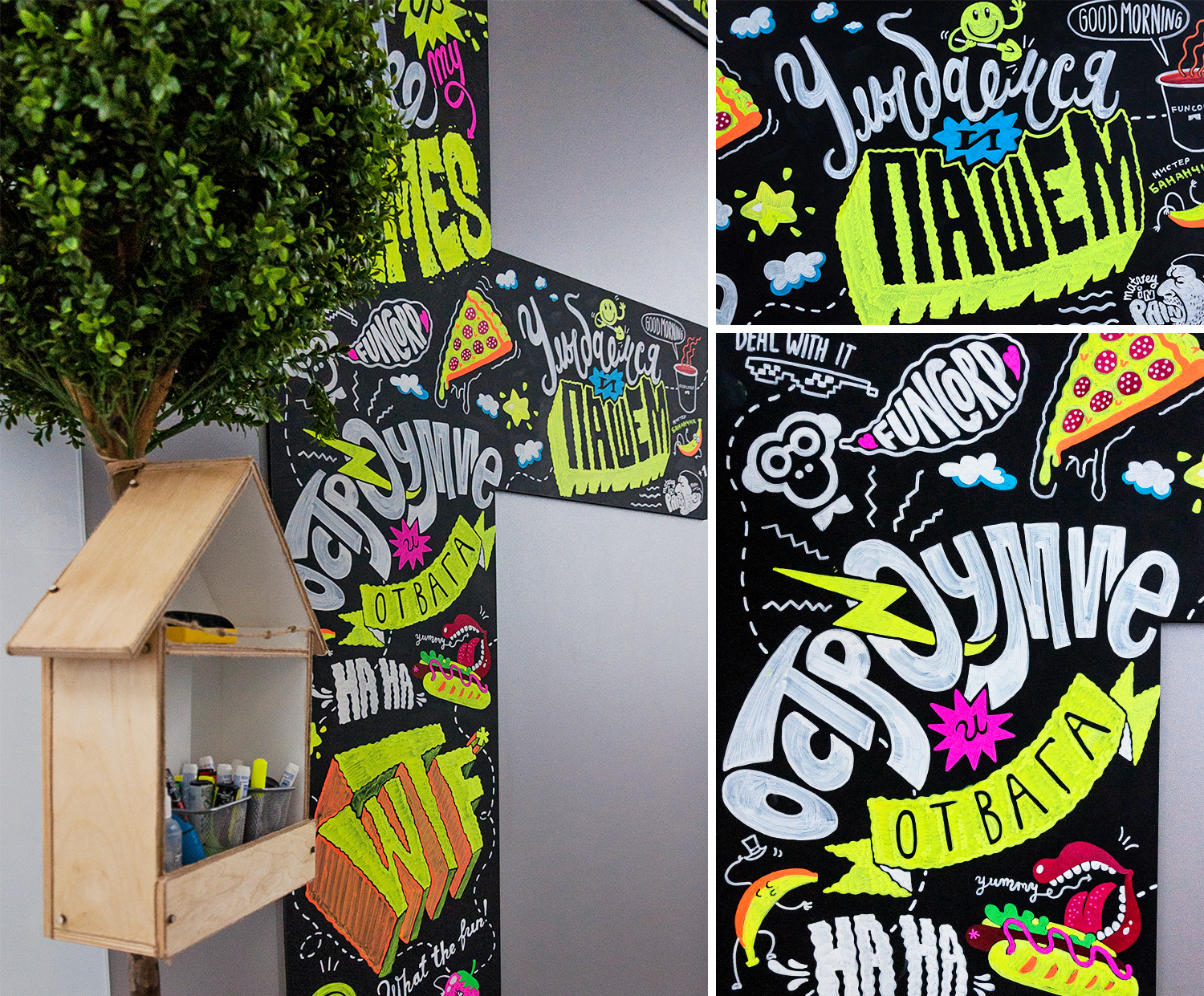
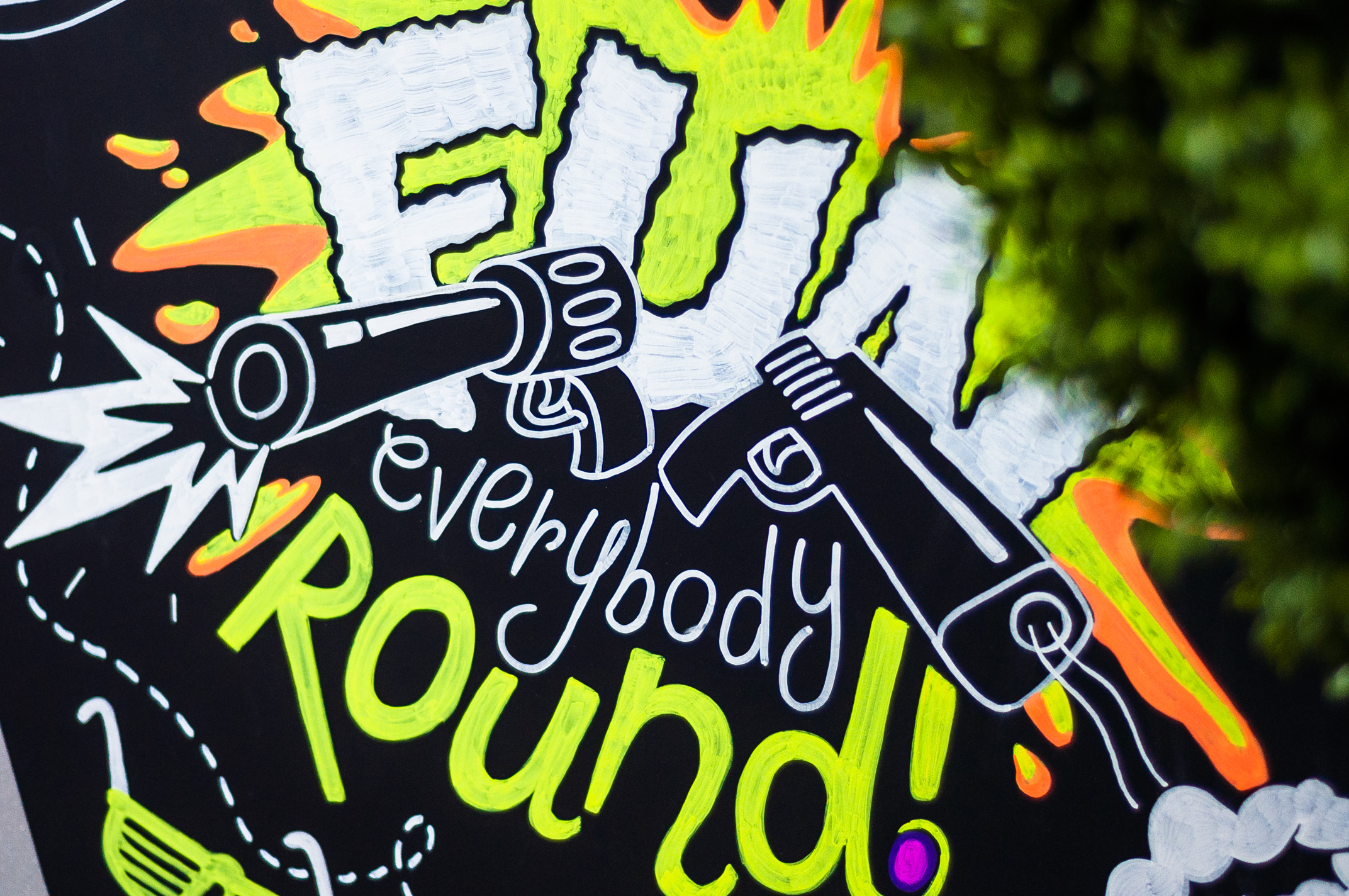
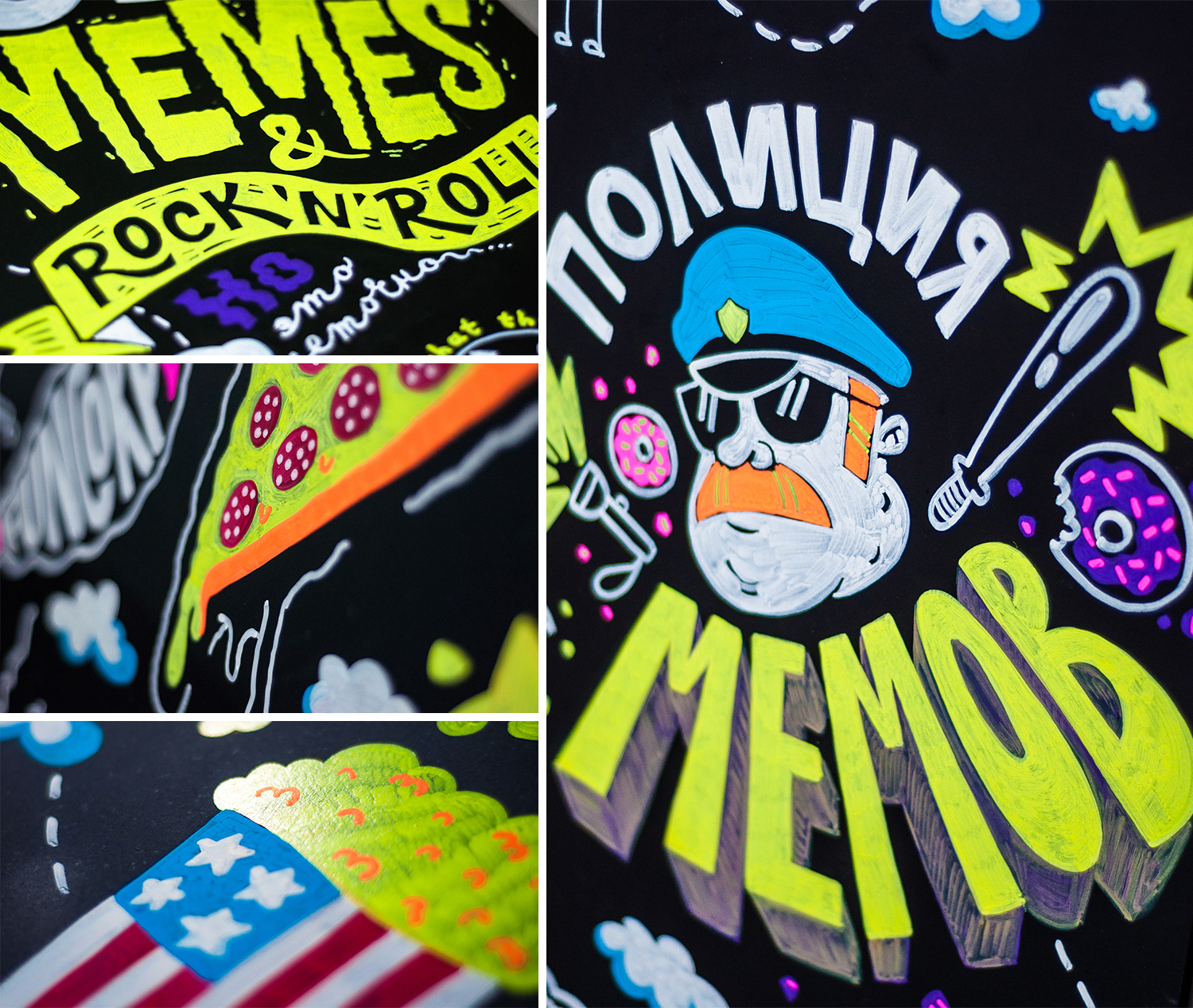
We also decided to leave room for our daily creativity to our colleagues, so the middle letter U was given to everyone to relieve stress and freely draw.

I want to share the acquired experience with those who are inspired by the idea of chalk-marker drawing. The following tips, I hope, will save you from newbie mistakes.
PS It's hard to say why I wrote this article: whether to inspire designers to get up from their chairs more often and not be afraid to do something with their own hands, or to convince brand managers of the creative potential of live lettering, doodles illustrations, non-standard materials ... But if at least someone, having read it, will decide to pick up a marker and write something - this will undoubtedly be an excellent result!
I will talk about what is lettering in modern design on the example of my work on an art object; about the difficulties I faced and how I solved them; about slate paint and chalk markers. And why is it "good for business". And there will be some motivation for designers who would like to get up from a chair, but do not know how.

It all started with the fact that our department had the task to make huge letters FU N. So that from the floor to the ceiling, so that the maximum fan was guaranteed to our guests from the very doorstep of the office, and the employees received a charge of cheerfulness, passing by every day.
')
What does the designer do in such cases? Nothing.
How does a designer do nothing?
The hands - nothing.
We are graphic, product designers and interface designers - we sit down in our chair (and more often we sit in it), open Adobe Illustrator and type FUN in corporate or any other nice typeface and send the file to the advertising and production company ...
And wait.
Soon the guys will come and implement our design in real life. Glue what needs to be pasted, paint what needs to be painted ... or what they do there, these advertisers. The designer usually needs only to evaluate the result and either rejoice or sob.
And here I, the interface designer, opened Adobe Illustrator and typed it:

Very corporate, considering that the base color of the brand is black. On this, my work, in fact, ended, but to calm my conscience (and the management team), I made a mocap. Here is this:

And this:

And it became obvious that huge black letters are not fun at all.
Looking at them, I do not want to run wildly to work and develop as a specialist. They do not motivate, and even slightly oppress their mourning appearance.
This means that the task is not solved by me as a designer. Having understood this, our department gathered to brainstorm, the outcome of which was the decision to realize the mission of FUN letters to the maximum, filling them with vivid content. Bright, interesting, daring and, of course, corporate. This meant the development of a unique 3 meter by 5 meter illustration. The illustration implies the need for an illustrator, and God knows why I decided that this challenge is in my teeth.
The whole world chooses lettering, and we also chose
Lettering (English lettering - drawing letters) gives the artist the freedom to turn the text into a drawing, supporting and strengthening its semantic content.

Jay roeder
Perhaps that is why lettering is so popular all over the world, because it has absorbed the strengths of two expressive means: drawing and text. Handwritten inscriptions and fonts were one of the significant trends in illustrative art last year, and you can be sure that this lettering will continue to gain popularity. Indeed, while digital technology captures an increasing part of our lives, creative people are looking for ways to re-personalize the design, to return the human element to it.

Timothy goodman
You know, there was one interesting research (alas, I don’t remember which company was involved in) where product labels were shown to consumers to choose the most pleasant options. Then the marketers were quite surprised to see that the printed and typed text with a large margin won the drawn labels. People unconsciously rated the design by hand.

Chris Piascik
And if we see few examples of lettering in everyday life and on the streets of our native city, the reason for this is still a small popularization of this trend among the leaders of large and medium-sized businesses in Russia (at the moment). But this is an amazing thing, just look:

Jason naylor


Chris Piascik
Business giants such as Google, Coca-Cola, Nickelodeon, Reebok, Converse, Nike, McDonalds, Facebook, Xbox, Forbes, Vogue, etc., boldly use lettering on a wide variety of events and in their products. And with the work of Russian and foreign lettering masters can be found on Instagram and on Behance on request #lettering . We got acquainted, were impressed and realized that we had found a fresh stream and an ideal way to transfer our ideas.
Dudling is another new word and cool illustrative style.
In the world of Instagram, Behance and Dribble you can now find many illustrators with their own unique styles, but if you (like me) are not one of them yet, you shouldn’t worry. Our own style is born from daily practice, but first we all look at the "great", analyze their work, charge them with energy and ideas.
One of the latest trends in illustrations in 2017–2018 is dudling (from the English. Doodle, which can be translated as “scrawl”, and doodling - unconscious drawing).

A doodle is what our hand draws while the brain is busy with another matter (for example, talking on the phone or listening to lectures). If, however, to connect consciousness to the dodling, it turns out to be a very distinctive, incredibly free illustrative style that has fascinated many.
Choosing in which direction to move, we involuntarily came to the use of doodling. Its advantage is that it is possible to organically accommodate many messages, images, phrases, slogans (and easter eggs) in one canvas, combining them with a single style space. It is interesting to examine it, reading like a book, only in an arbitrary order: from top to bottom, from right to left ...

Chris Piascik
The illustrators @timothygoodman, @andyjpizza, @chrispiascik will be great sources of inspiration and a demonstration of how diverse and interesting doodle art can be.
Well, what shall we draw?
So, we have decided on the style, it remains to generate the content, i.e. the content of our illustration.
This was the second big reason I, as a product designer, took on the task. Nobody knows and does not love your company as you yourself. An invited illustrator may bring his own style, but he is not familiar with your brand, and after all, a brand is a living being. He has a certain collective personality with a set of individual qualities that managers like so much to list in technical tasks for logo development in the column “Describe your brand”: young, innovative, reliable, stable, friendly ... Absorb all these 50 shades of the brand, rethink and broadcast as an intelligible design solution is quite difficult if you yourself are not cooking in this saucepan. Therefore, working with a third-party specialist often requires a long synchronization between the customer and the performer, which includes a magic ball fortune telling, thoughts reading sessions and endless edits that are equally painful for both parties.
We decided that nobody knows better than us how much we appreciate good fun, courage and thinking beyond the scope of the task, hooliganism on the verge of trash, informality for the sake of productivity ... everything that FunCorp creates.
And the design and administration teams met for a brainstorming session and decided on the content theme. It looked like this:

There was a hodgepodge of corporate slogans, mottos, ideas, just funny and spiritually close phrases, slightly peppered with Slack's internal jokes.
This was followed by weeks of individual work in conjunction with the iPad Pro + Apple Pencil + Adobe Draw, which I recommend to all interested parties to master because of its high technological capabilities, incredible performance and convenience. As a result, the layout of the illustration was ready to be transferred to the letters FUN, which at this point had been produced and assembled (I will talk about them in a little more detail in the chapter on chalk markers).
Live Drawn is Better Printed
Of course, it is much faster and easier to print illustrations on self-adhesive film. Faster and cheaper. Cheaper and duller. And Facebook would never do that, and Facebook knows a lot about creatively enlivening the space of its offices!
In Europe and America there is such a profession, which is not in Russia, it is called signpainter. In translation, this is probably the signage artist. These are people who in our digital era with a brush and paint create signs, window dressing and building walls. Foreign artists also strongly pressed the invention of the plotter cutting, but still this profession exists and is now experiencing, perhaps, its Renaissance era (the documentary SignPainters (2014) will introduce you to it).

Mike meyer

@copenhagensigns
So why is hand-drawn or hand-made always valued higher than stamped, even if the plotter cuts out smoother? Because that's how our brain works. We feel that behind this is a real person, his living work and talent, his vision of things, and we appreciate the opportunity to touch what enriches our visual culture.

Stefan kunz
We really wanted our FUN letters to be alive, to talk to the viewer, attract the eye and fascinate his imagination, so we decided that the illustrations should be painted on the surface of the letters in the most classical way - with the hands of an illustrator. Inexperienced, but loving.
Is it reasonable to paint if you are not an artist?
Even the designers of ancient Rome knew: ubi nihil vales, ibi nihil velis (lat.) - “where you can’t do anything, you don’t have to want anything.” A reasonable question: why go to an area where you are unprofessional?
That is, perhaps, in childhood you did a good job of drawing horses, and now you draw excellent interfaces, and your grandmother calls you an artist, but when it comes to the task within the brand design, is it wise to take responsibility for a job that you don’t even know how to approach? Risking to give out as a result unknown nonsense, for which you will at best be deprived of a quarterly bonus?
I have no answer to this question. But I think something like this we leave the comfort zone. And the comfort zone in the creative profession is a professional death.
I believe that, contrary to the prevailing stereotype, any designer is an artist. Even if he draws not with his hands, but with his head, working exclusively on the trackpad of his laptop. And when the product challenge (and the blessing of leadership) gives us designers a chance to step into a wonderful new world - it should be missed.
Acquaintance with the works of modern illustrators broke the stereotype in me that everyone should do their work, and the designer’s lot is Adobe. All these unusually talented artists in one voice say: do not be afraid to start, do not hesitate to look unprofessional, just take it and do it! And enjoy it!
Chalk markers and what they eat
Chalk markers are what the barista of the whole world writes “Cappuccino - 250 rubles” on their boards.

We chose the chalk markers to transfer the image to our rather big black letters. “But they are erased!” - you will say. "Exactly!" - we will answer. This means the freedom to change the content of the illustration in the future. “Well, if a barista can, then I will succeed!” - with such a slogan I began to study the lettering with chalk markers.
Immediately make a reservation, chalky lettering and lettering with chalk markers are not quite the same thing. The main difference between chalk markers from chalk is that chalk leaves a more loose, non-uniform mark; markers, on the other hand, give a clean, dense line, do not pour out and are stable after drying. These are two similar, but different tools, and it would be illiterate to say that one is better than the other, since each solves his own problems. Our problem was solved ideally by chalk markers.

Chalk marker is also called paint marker, chalk ink, chalk pen, bistro marker, glass pen, liquid chalk, but more often chalk marker.
It's funny that this name does not correspond to reality, because, contrary to the stereotype, inside the chalk markers there is not liquid chalk, but special water-based pigment inks. This pigment has several winning points: it is resistant to ultraviolet radiation and does not fade in the sun, and also it has a very good "hiding power", that is, it well overlaps the color of the surface on which it is applied. Due to this, a very saturated color pattern is achieved. Chalk markers can be used on glass, plastic, metal, LED-board, slate paint and on other solid, non-porous surfaces. The drawing is easily washed off with a sponge with water (and even better with a sponge with a special agent for washing off chalk markers).
You yourself, most likely, are already familiar with chalk markers as a tool for children's or office creativity. You may have seen the chalk inscriptions on the boards in restaurants, shops, during the design of weddings or banquets. Meanwhile, they certainly deserve more attention.
How to choose a good chalk markers?
We tried the markers of these brands personally and were satisfied: Edding, Uni Chalk .
And these are other leading brands on the market: Zig, Molotow, VersaChalk .
The market is now flooded with chalky markers from a variety of companies (including Chinese), but it is better to trust the well-known manufacturers. The average price of one marker varies from about 200 to 400 rubles, depending on the size of the tip and the amount of ink in the tank.
How to choose high-quality chalk markers? The following criteria will help you:
- two-sided tip at the marker (when one side fails, it can be turned over and reused, and one side is oval and the other side is beveled);
- a large color palette in the lineup, the presence of fluorescent colors, the presence of a line of tips of different diameters and shapes;
- refillable ink reservoir (this is a great rarity: I found refill only for Molotow CHALK markers).
It could be said that the quality and density of the line first of all speak about the quality of the chalk marker, but these properties are difficult to estimate when buying a marker from an online store, and most likely it will be more convenient for you to buy them exactly there, like any narrowly specialized art product.
What can you draw with chalk markers?
We have chosen for letters eco-friendly and light plywood, qualitatively primed and coated with a special blackboard paint Blackboard paint. Slate paint is not uncommon now, and observing the technology of painting, you will surely get a good result, whichever one of them is chosen. I will give only a few tips:
- choose a surface that prims well and do not neglect the quality primer;
- Before buying paint contact the manufacturer and specify the properties. Slate are frosted and glossy (it is better to choose in advance what effect you want to get);
- make a probe of the product, and if necessary, not one.

We made about 7 small test letters, experimenting with various combinations of materials, until we finally came to a combination of plywood and matte slate. This combo with glitter passed the test (draw - we estimate the brightness and consistency of the line - we erase it with a wet rag - we dry it - we estimate the cleanliness of the canvas - we pick it with the nail, we scratch it - we evaluate the strength).
But you can use chalk markers not only on the surface with slate paint. There are many other options where you can use them for business benefits:
- on the glass (the design of glass windows and windows. The pictures can be changed at least every week, though you will have to get hold of an artist in the state);
- on the mirror (for interior decoration or other non-trivial ideas);
- on metal and plastic (for temporary branding of products or to write a joke on a colleague’s favorite circle or instruction for a coffee maker);
- on marker and magnetic boards of all types (to make your presentation or report more vivid and alive).
FUN letters are ready


Our letters began to perform the fun-mission already in the process of drawing, as all the employees passing through the corridor were entertaining themselves with the contemplation of the UX-designer, who was hanging on the stepladder under the ceiling, now lying on the floor mat and carefully painting certain areas of letters. :-)



We also decided to leave room for our daily creativity to our colleagues, so the middle letter U was given to everyone to relieve stress and freely draw.

Layfkhaki for a beginner chalk-marker artist
I want to share the acquired experience with those who are inspired by the idea of chalk-marker drawing. The following tips, I hope, will save you from newbie mistakes.
- Keep a stock of markers, as they tend to end fairly quickly with intensive drawing. Buy immediately more than you need, so you don’t have to re-order and interrupt the work process (as we did).
- Prepare a stepladder, various sponges and cotton swabs for error correction, microfiber cloths, erasing liquid - all you need.
- Before applying the drawing to the surface, make and approve the layout (unless, of course, your design does not imply free meditative doodle drawing, as, say, Shantell Martin does. Then just “follow the line”).
- A very great help to transfer the layout to the real surface will be the projector. This is a “chitcode” for an amateur artist and a guarantee that the result will fully match your layout. The projector helps to maintain accurate proportions and, undoubtedly, significantly speeds up the work.
- Test your markers before starting work. Get used to the shape and thickness of tips, learn from your experience how to soak a tip with ink when drawing, how to preserve its integrity, avoiding strong pressure and "rubbing up". Some ink is brighter and more “opaque" than others, some can be applied only in 1 layer, and then they begin to scrape the bottom layers. All this can be learned only by making a few test drawings.
- For super-saturated colors, wait for the first layer to dry and apply the second and third where possible.
- Colors are mixed! You can go through the purple layer of yellow - and get the color khaki, on the white crimson - and get pink. You can also create gradients, and it is very beautiful. Mixing the colors of chalk markers is not very practical, because you stain the tip of the marker with a different color. The good news is that it can be removed and rinsed with water.
- Colors are mixed-2! Remember this when you decide to paint with one color on top of another. You may get an unexpected result, as the wet top bar will dissolve the dry bottom.
- And finally, a pleasant nuance: the markers that have the word neon (neon) in the description, as well as the white marker fluoresce well under UV light.
PS It's hard to say why I wrote this article: whether to inspire designers to get up from their chairs more often and not be afraid to do something with their own hands, or to convince brand managers of the creative potential of live lettering, doodles illustrations, non-standard materials ... But if at least someone, having read it, will decide to pick up a marker and write something - this will undoubtedly be an excellent result!
Source: https://habr.com/ru/post/352750/
All Articles